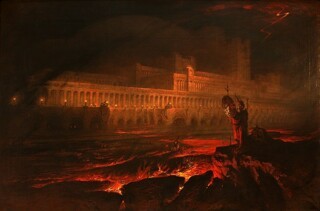Rivers of Fire
Liam Shaw
The Cumbre Vieja on La Palma is a volcanic ridge that last erupted in 1971. A monitoring report filed in early September this year reported an ongoing ‘seismic swarm’: a group of small earthquakes around 10km deep. This can be a sign of magma rising from the molten mantle below, pushing the crust upwards and splitting it.In Journey to the Centre of the Earth, Jules Verne sends his subterranean explorers back to the surface on a rising column of ‘a kind of lava paste’, which ultimately ejects them from the mouth of a volcano.
On 19 September, lava began pouring out of the Cumbre Vieja. The initial flow had a temperature of more than a thousand degrees centigrade. It spread at seven hundred metres an hour down the steep island slopes towards the sea, slowing as it cooled. Over six thousand residents were evacuated and the island declared a disaster zone. Ten days later, the lava reached the sea and solidified, spreading out into a ‘lava delta’. Two months later, over two thousand homes have been destroyed and the total area covered by lava has reached more than a thousand hectares. The activity hasn’t stopped. Fresh eruptions are still occurring.
Despite its name (‘old summit’) the Cumbre Vieja is a relatively young volcanic ridge. It was formed around 125,000 years ago. Eight eruptions have been recorded since the fifteenth century. The latest is the largest and most damaging.
We have an eyewitness account of the 1646 eruption in the form of a letter from the governor of Tenerife, Alonso de Yclan y Valdès, to the king of Spain. I consulted the copy in the British Library; it was almost like reading the news. The eruption began on 4 October, the feast of St Francis. After some small earthquakes (‘algunos temblores de tierra’) a huge noise was heard, as if from thick artillery and musketeer skirmishes (‘artilleria gruessa, y escaramuças de mosqueteria’). Then observers saw rivers of fire (‘rios de fuego’) running down into the sea, where they slowed and thickened into material like stone.
The governor seems unsure of the right terminology for what he is describing. But lava is now firmly part of our modern conceptual universe, even if for most of us it remains a state of matter bound by the laws of cinema rather than physics. One resident of La Palma described the experience of the last two months as like ‘living in a comic book’.
Before the nineteenth century, witnesses who hadn’t seen lava flows before turned to mixed metaphors: fire and water. The word ‘lava’ is thought to derive from a word for a sudden stream of water caused by rain. When Francesco Serao described Vesuvius in 1738, he introduced into his Italian text the Neapolitan word for these floods of molten and red-hot materials: ‘quel profluvio di materie … che i nostri chiamano Lava’. In other words, ‘lava’ originally referred to the flow rather than the material flowing.
It took a while to become a material in its own right. To most European artists it remained remote, even when they wanted to paint volcanoes. Biblical ‘fire and brimstone’ was more graspable, even if it produced depictions of volcanoes that looked more like hearths spitting cinders than real eruptions.
One of the first painters to use lava effectively was John Martin. It took him time to work out how to manage it as a material. You can see this artistic development in two versions of Milton’s Pandemonium. An engraving of the scene made in the 1820s shows thin trickles of lava dribbling along gullies. By 1841, Martin has worked lava out: the molten rock is a viscous flood, dominating the scene with its infernal red light.
The modern taxonomy of lava was largely established around the same time. One of the first classifactory systems was published in 1858. Modern schemes divide lava according to its visual appearance: smooth pāhoehoe and rough ‘a‘ā. Both terms are from the Hawaiian language. Pāhoehoe produces silky pleats and ripples. When colonisers brought satin cloth to Hawai‘i, it became known as pāhoehoe: the analogies can flow the other way too.
The Cumbre Vieja flows I have seen in videos look to me like ‘a‘ā. There is a third type: block lava. These lumps of molten rock can be enormous. As the Cumbre Vieja eruption continued into October, part of the ridge’s flank collapsed, and blocks of lava the size of ‘three-storey buildings’ rolled down hills.
The vast forces involved in tectonics give rock a suppleness we associate with other materials: from Vernes’s ‘lava paste’ to the satin folds of pāhoehoe. Solid rock becomes elastic. As El País reported, just before the eruption the whole island of La Palma had grown by ten centimetres, bulging outwards like a rocky bubble.
Volcanoes can destroy suddenly or slowly. In contrast to the catastrophism we associate with Pompeii or Pinatubo, the videos of sluggish yet implacable lava flows swallowing buildings in La Palma give a sense of the temporariness of human construction on geological timescales. The Cumbre Vieja eruption seems to be decreasing in ferocity, but the lava keeps flowing. On 27 November, it covered the cemetery in Las Manchas, sealing three thousand graves under a cooling layer of molten rock.
